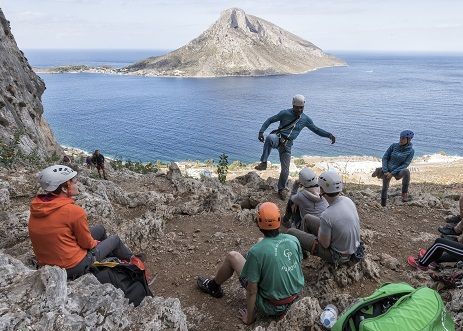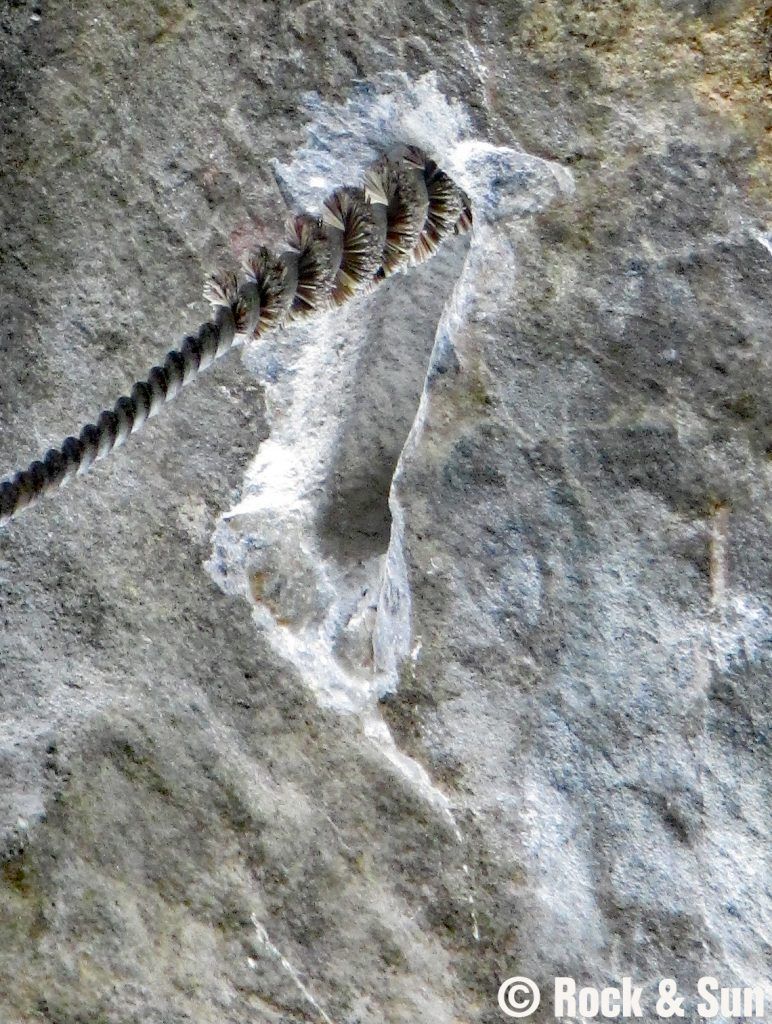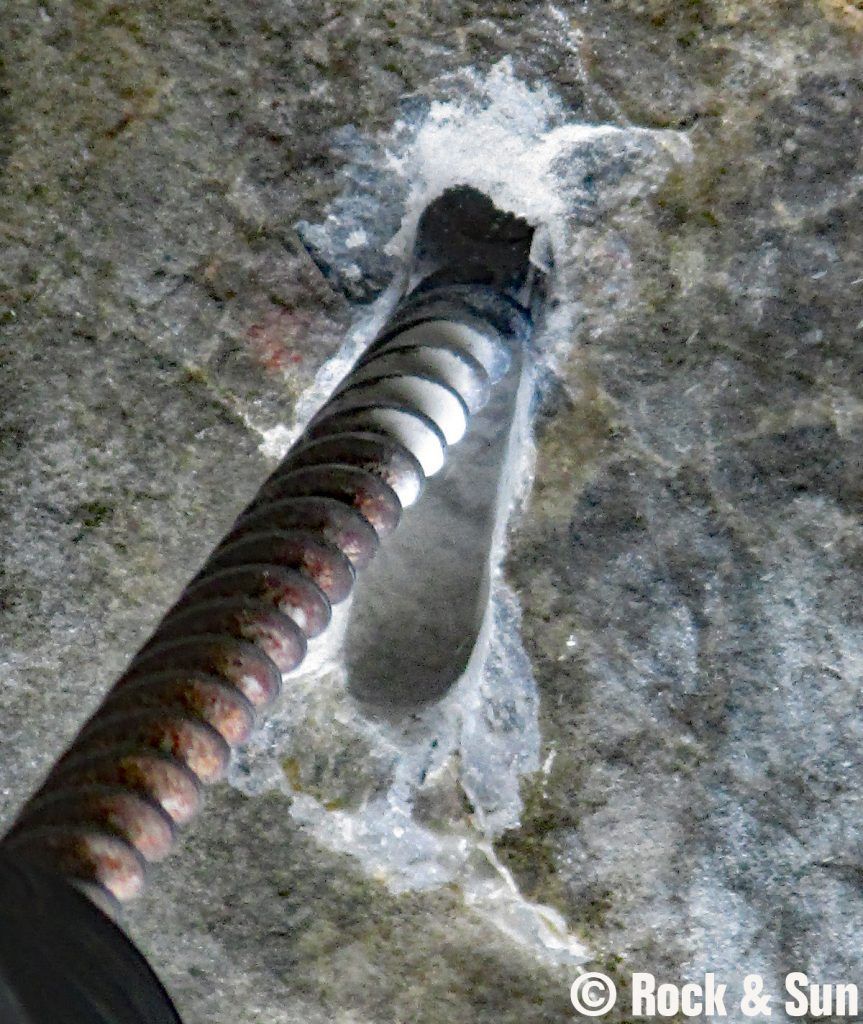Outdoor Climbing Coaching
Recently the demand for outdoor sport climbing coaching has increased hugely. Due to the amount of Performance Coaching Courses I have run I notice some patterns in the way climbers tend to move. Much of this might be down to the way we as humans naturally move on rock. It’s also possible that the nature of artificial climbing is playing a large part in forcing people into a pattern of movement that is at odds with the way you would ideally want to move on rock.
Having been a climbing instructor for over 30 years it seems that much has changed. Both physically and in the way people move. Clients are generally fitter and stronger, the grade they climb is generally higher than it used to be, but the gap between the grade people climb indoors compared to outdoors seems to be widening. What I find most interesting is seeing a well-established pattern of movement which is very similar from one climber to the next. Before climbing walls became popular, as a guide, you would most likely be introducing someone to climbing for the first time and they would therefore try to execute the moves and techniques that you explained as best as they could. These days however, the average client has already been climbing indoors for about two years and has a well-established pattern of movement.
When modern climbing gyms appeared on the scene in the early 1990’s they were very much seen as a place for climbers to train, build and maintain fitness during times of poor weather and the long dark winter months. But how well do they work nowadays for the new climber looking to progress outdoors?
The pattern of movement that climbing on artificial walls is likely to produce
Climbing indoors likely develops a pattern of movement that is best described as: a high, often wide step (anything above the opposite knee is a good indication of what might be considered high), very little sideways movement of the hips if any, then pull on the arms before rocking over the high foot. This move is usually executed with a trailing back leg (a heavy limb weighing you down as you try to move up). This is about as inefficient a move as you can make.
Of course there comes a time when a high step rock over is necessary. However, if we are just doing so out of habit and missing the easier options when available we are unnecessarily wasting valuable upper body strength.
What makes us more likely to establish this pattern of movement when climbing indoors?
The limited options of foot placements on an indoor wall compared to rock as well as the difficulty in smearing on indoor routes can greatly reduce the opportunity to practice and develop basic non-technical movement skills. That is, if we choose to climbing the routes as they are set. In order to establish an efficient way of moving we need to understand what an ‘efficient basic movement pattern’ is.
When climbing outside, especially on the easier routes, an almost limitless number of foot placements options are available. Indoors however, in order to make routes harder, the holds will become fewer, smaller and placed further apart. Once a climber progresses through the grades they are often left with little option but to be climbing out of position (i.e. off balance) – with their feet much wider than the body’s centre of gravity and too high to be able to shift the hips sideways over the high foot in order to be balanced over the foot prior to the body moving upward. If this sideways movement does not happen it causes an over reliance on the upper body. When making the transition to the outdoors climbers are unnecessarily repeating these moves. They move in a way that their body has become accustomed to; high-step, pull with arms, rock over. The feet are moving past perfectly good foot holds to recreate a body position that feels ‘natural’. In reality it’s a bit more complicated than this but this is essentially how almost everybody is moving on the first day of a coaching course.
What might constitute a non-technical efficient climbing pattern?
Place your foot on to a hold. Then transfer the body weight onto the foot by moving the hips over the foot. It is possible to do this without the body moving up. In fact, if the body moves down as it moves sideways the arms can usually straighten. When fully balanced over the high foot, bend the knee of the opposite leg and use the hip joint to raise the leg and foot until it reaches the next foothold. All of this can be done without the hips moving in an upward direction. Now the body can be pushed up by straightening both legs; generating the upward momentum from the legs rather than pulling on the arms.
Climbing a ladder
I find the ladder analogy a good place to start when coaching outdoors. If the aim is to use the legs as much as possible protecting our weaker upper body then it might be useful to think about common terms we use to describe easy climbing such as: easy as climbing a ladder. What makes a ladder easy to climb? How would you design a ladder if you were going to make one?
The rungs would be close together below knee height and the width no wider than the hips. This way the feet are always directly underneath the body and never outside the width of our body. Making moves where our high foot is relatively low are easy to execute with minimal upper body strength. However as soon as we take our foot above the opposite knee pressing up from one leg starts to get hard so we tend to pull with the arms. The same is true when the foot is beyond the width of our body. If we don’t move our hips sideways over the high foot before lifting our back foot then our arms are holding a good percentage of our weight and we are therefore out of balance. Of course it is not always possible even when climbing on rock to keep your feet within the confines of a ladder but the more confident and skilful the climber is in their footwork, the more able they are to avoid being drawn out of position by bigger footholds that might not be best placed for transferring weight onto.
Having a non-technical movement programme allows us to focus on maintaining our form, and to easily recognise when we are choosing to go out of position and are no longer able to move our hips over the lead foot. If we can recognise this we can more easily select the correct body position in order to execute the next move efficiently.
Analysing Movement Patterns
In the following sections I will be looking at how to analyse climbing movement and how to use the climbing gym effectively to develop efficient movement.
The motivation for writing these articles came about from coaching hundreds of clients who mainly climb or at least learnt to climb indoors. I was struck by how few of them understood any of the differences and how even those that had been coached assumed that what they had learnt indoors would help them climb on real rock.
Analysing a climbers movement pattern on an artificial wall can be difficult unless the climber is on a section of wall with an abundance of hand- and footholds (enough holds and easy enough grade that they are able to choose where they would like to place their hands and feet). The climber ultimately needs to be able to move freely and not be dictated to by spaced holds.
Filming climbers on easy routes, slabby or no more than vertical grade 3 to 5 even if they normally climb upwards of 7b, allows you to see how they naturally move when given a choice. If training mostly indoors and climbing the routes or problems as they are set, there is a risk of training our bodies to seek out the hard moves and overlook the easy ones. If we accept that climbing efficiently is important as a climber then we need to naturally seek out the easiest option. Of course, being able to execute hard moves is important but if our body naturally falls into familiar but unnecessary positions when on easy ground then we are wasting valuable energy. Climbing is a technical, balance based activity and executing moves when out of balance using the arms instead of the legs should be a last resort not the norm. I’ve coached many climbers in recent years who almost only do difficult moves, not seeing or considering an easier option as this would feel unfamiliar to them.
Once we understand what efficient movement is, we can choose to do a much greater percentage of climbing where we are not being dictated by the configuration of the holds. For example, if 80% of our climbing allowed us to move in a way of our choosing and we saw this as practice, we would have some quality control over how we move. If mostly practicing indoors this might involve climbing on sections of wall with many holds and using any colour for feet.
Based on efficient movement, what are we trying to observe?
I find it useful to start with transference of weight.
Is the climber fully moving the hips/centre of gravity over the leading foot? If not, why not?
Is the climber trailing the back foot as they move upward (climbers often arrive with a hole or wear mark on top of their shoes, this can be a giveaway), pushing from one leg rather than two?
Are they pulling on their arms or pushing from their legs?
- Bent or straight arms?
- Climbing dynamically or statically?
- Making more hand movements/changes to foot changes?
There are many things that we can choose to look at when assessing how efficiently someone may be climbing. It’s best to keep it simple. It’s important to have the basics wired before moving on to anything more complicated.
Most if not all inefficient movement will be due to poor choice of foot- and hand holds. As good footwork is harder to develop it makes sense to concentrate more attention here.
The higher and or wider the leading foot is in relation to the back foot the harder it becomes to transfer weight onto it. Once the foot is above the opposite knee the leg is not strong enough to push the body up alone, so the arms need to help by pulling or pushing. For this reason, I begin with foot choices. If they are high, wide or both, I try to identify what techniques (if any) are being used to make upward movement as efficient as possible.
People are often surprised when they look nothing like they imagined on the screen. For most people it will be the first time they see themselves climbing. The fact that they are not flowing up the route with the grace of one of climbing’s greats can come as a bit of a shock!
It’s useful to have some positives to throw in with the analysis which if we are not careful can feel like a negative process (looking for things that the climber might be doing incorrectly or inefficiently). I must admit I’m pretty rubbish at this bit! I’ve learned that referring to how I know I used to climb before I took more of an interest in movement can help. But also looking at techniques the climber is using to compensate for being out of balance can help, as they are useful skills to have when climbing harder routes or features that require certain techniques. Watching how most climbers around them at the wall or crag will be moving with the same pattern is also useful.
From watching the video, it should be clear that if it is possible to take small steps, keep our feet close together then the climbing is naturally easier. Once the feet are outside the width of the body, sideways movement is necessary to move efficiently. The link below shows two climbers on the same route. The second climber is making good choices with the feet and displaying excellent technique.
How to make high or wide steps efficient
It is important to consider if poor footwork is the cause of us making poor choices with our feet in the first place. Often the inability to smear or stand on small edges is at play. When we must take our feet out of position, there are surprisingly few techniques that we might choose from:
- Bringing our feet closer by stepping down with the high foot, bringing the back foot up a little before going back to the same highest foothold. Not really a technique; more away of avoiding the high step and remembering that this option often gets overlooked.
- Cross over or through with the foot when going sideways.
- Palming off or pushing down with the same hand as the foot we are going to move.
- Dynamic rock over by bouncing off the back foot, generating movement from the legs to limit pulling on the arms.
- Bringing the back foot up incrementally rather than in one big movement.
These options (apart from the dynamic rock over) should be made without upward movement of the body / hips.
Climbing is a discipline
Climbing is a discipline and like any discipline practice is necessary. Most climbers are self-taught and judge their expertise by the grade they climb, not necessarily by the quality of their movement. Most climbers just climb hoping or assuming they will get better. However, once we understand what efficient movement is, it becomes possible to self-coach. If we are present in the moment with each move we make and are prepared to fail seeking out the technical solution, rather than just pulling even if we know that we could, then we are practicing, and will make progress. Practice can only be done on routes easy enough to have both mental and physical space to consider each move.
By Trevor Massiah
This article was published in two parts in Professional Mountaineer Spring and Summer 2018
Interested in a Performance Coaching Course?
For more information and available dates, https://rockandsun.com/rock-climbing-courses/climbing-coaching/
[soliloquy slug=”costa-blanca-climbing”]


